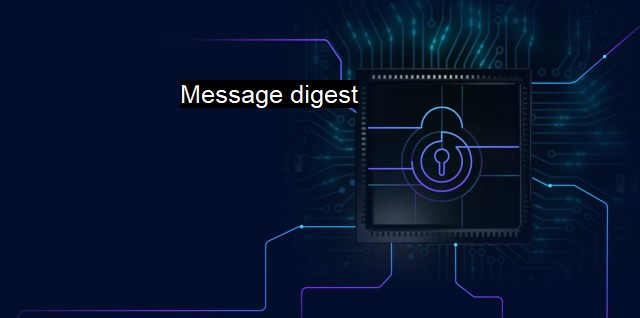What is Message digest?
Exploring Message Digest: A Crucial Component of Cybersecurity and Antivirus
In the era of growing digitalization, the aspect of cybersecurity is pivotal to our comprehensive understanding of a secure framework for data management and system protection. Within this framework, we have concepts that significantly contribute to accomplishing cybersecurity goals. One such fundamental concept in digital security mechanisms is a 'Message Digest.' This article aims to provide a detailed explanation of what "Message Digest" is with the context of cybersecurity and antivirus.Whether it's for online shopping, online banking, social networking, or merely sending an email, all these digital setups come with an inevitable yet vulnerable requirement - Passwords or sensitive user information. The highly concerning risk associated is what if the required private information (passwords or user-information) gets into the wrong hands. It gets more problematic if the stored forms of these sensitive informations get directly accessed or deciphered by hackers.
In this scenario, a crucial role is played by a message digest. A message digest can be understood as a cryptographic hash function containing a string of digits created from a password or any data source. It associates digital elements with seemingly random string sequences. If one were to alter even a polygonal aspect of the original data, the computed hash would vary drastically. In effect, the notion of a Message Digest escalates cybersecurity by introducing an unpredictable and nearly unique data representation.
Soundly underlining the essence of a Message Digest in the framework of cybersecurity, it provides an excellent mechanism for validating data integrity. It answers an imperative security requirement – the certainty that the received data is precisely the same as the data sent, unaltered during transmission, and shielding systems against possibly harmful data manipulations. Hence the technique can offer an impeccable layer of cryptography specially designed to defend against notorious spyware or malware that might intend to compromise data integrity or confidentiality.
The digest plays a vital role in password storing scenarios within databases. Instead of keeping passwords in plain text, which is highly insecure and makes them easy-duration targets for a cybersecurity attackers, we store the message digest, or the hash, of the password. In simple computation procedures, a user enters a password; the system computes the hash of this entered password; if this generated digest (hash) matches the one stored in the database, it allows access. In this way, even if a hacker gains access to the database, reversing out passwords from these hashes is close to impossible due to their 'one-way' natural behavior.
Antivirus software makes significant use of Message Digests as well, commonly employing MD5 variants to ascertain that no changes have been made in their update files, or to check for identical pieces of a potential virus in different locations with speed and ease. Message Digest in a registry can also be used to identify changes made by illicit software or detect abnormal settings. Necessary scans by antivirus for validations heavily depend on the reliability and simplicity of message digest mechanism, greatly raising malware detection efficacy by facilitating accurate threat signatures mapping, fingerprinting files before and after their execution.
The selection of hash functions for creating message digests is often scenario-dependant owing to each's unique strengths and weaknesses. Algorithms such as MD5, SHA-1, and SHA-256 are commonly used. their adoption biases rely contingent upon a company's policy genres or scope of an application, often weighed by their respective complexity to reverse-engineer, their speed and security mandates.
a Message Digest can be seen as a cornerstone for countless cybersecurity configurations, a useful weapon in the arsenal of antivirus systems, and an essential shield for protecting digital data integrity. The humble yet powerful datum is indomitable in its service of providing security hatches in this ever-advanced computing world, all the while posing a firm stance against invasive elements that jeopardize our online life.

Message digest FAQs
What is a message digest?
A message digest, also known as hash function or cryptographic hash, is a mathematical algorithm that produces a fixed-size string of characters from any input message. It is often used in cybersecurity to verify the integrity and authenticity of digital data.Why is message digest important in antivirus?
Message digest plays a crucial role in antivirus software by enabling the software to scan for known viruses. The antivirus software computes the message digest of the files on a computer, and then checks them against a database of known virus message digests.How secure is message digest in cybersecurity?
Message digest is a highly secure method of ensuring data integrity and authenticity in cybersecurity. However, it is not completely immune to attacks. Cybercriminals can use various techniques to compromise message digest, such as collision attacks or rainbow table attacks.Can message digest be used to encrypt data?
No, message digest cannot be used to encrypt data. It is a one-way function that produces a fixed-size output from the input message. It is used for data integrity and authenticity, but not for confidentiality. To encrypt data, you need to use encryption algorithms, such as AES or RSA.| | A | | | B | | | C | | | D | | | E | | | F | | | G | | | H | | | I | | | J | | | K | | | L | | | M | |
| | N | | | O | | | P | | | Q | | | R | | | S | | | T | | | U | | | V | | | W | | | X | | | Y | | | Z | |
| | 1 | | | 2 | | | 3 | | | 4 | | | 7 | | | 8 | | |||||||